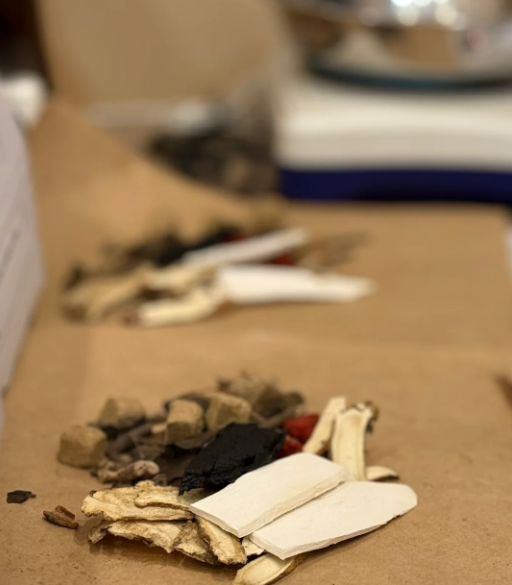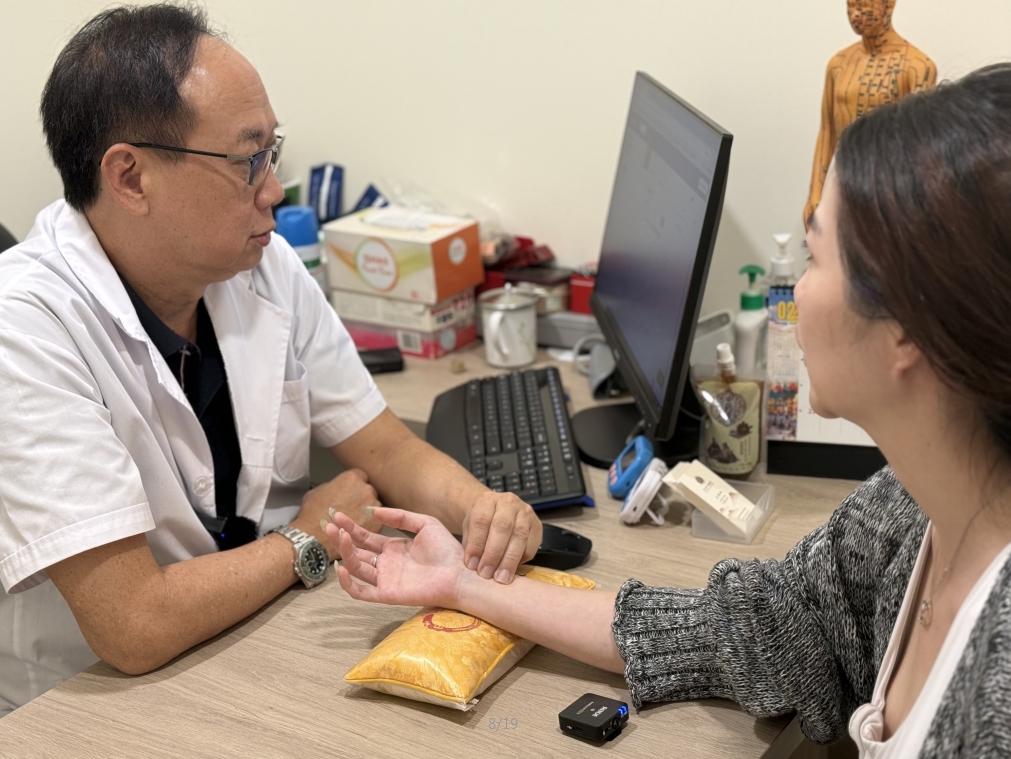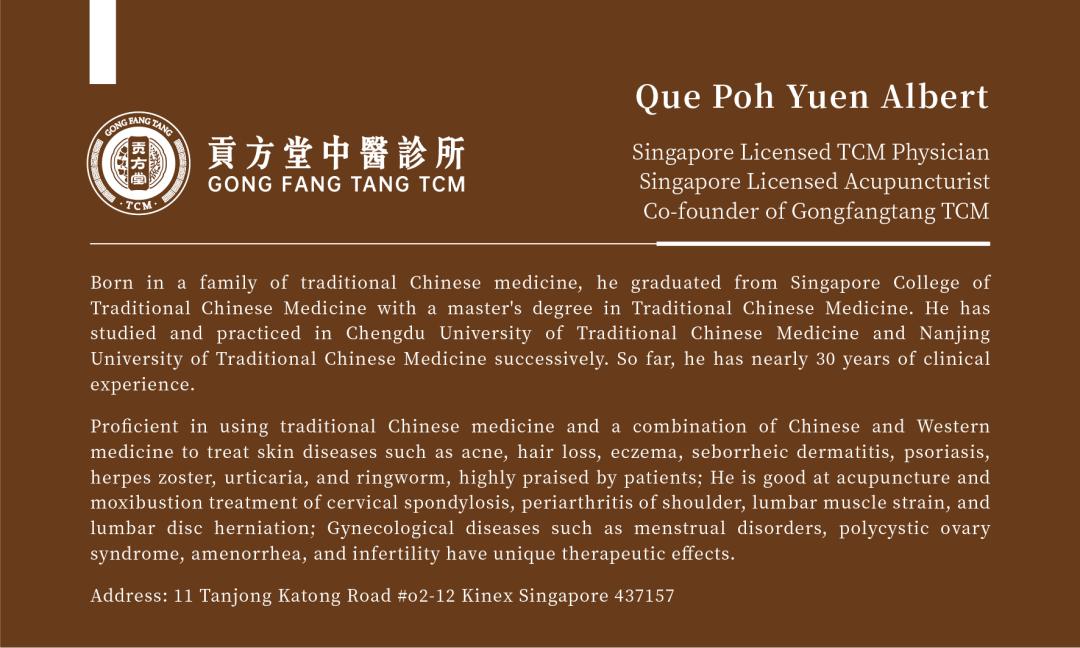- Physicians
- Clinics
- TCM
- Western GP
-
Fees
-
Deals & Privileges
- About & Resources
- Contact Us
Many women suffer terribly from dysmenorrhea (period pain), experiencing symptoms like lower abdominal distension and cramping, lower back pain, cold sweats, vomiting... What effective methods does Traditional Chinese Medicine (TCM) offer?

What causes dysmenorrhea?
Dr. Que Poh Yuen Albert, a TCM gynecology expert at Singapore's Gong Fang Tang TCM, explains that among the various types of dysmenorrhea, cold congelation and blood stasis is the most common.
According to TCM theory, "Cold causes contraction; blood congeals when encountering cold." When women consume excessive cold drinks or food, expose their abdomen to cold, or reside long-term in cold and damp environments, cold pathogenic factors can invade the uterus (bao gong), causing obstruction of Qi and blood circulation. This leads to congealed menstrual blood forming stasis. External manifestations include cold pain and tenderness in the lower abdomen, often accompanied by dark menstrual blood with large clots, cold limbs, a purplish-dark tongue, and a white tongue coating. If not addressed promptly, persistent cold and stasis can not only worsen dysmenorrhea but also impact reproductive health.

How does TCM treat dysmenorrhea?
For dysmenorrhea of the cold congelation and blood stasis type, Dr. Que Poh Yuen Albert strongly recommends Shao Fu Zhu Yu Tang (Drive Out Blood Stasis in the Lower Abdomen Decoction). This formula originates from the Qing Dynasty physician Wang Qingren's book "Corrections of Errors in Medical Classics" and is considered an exemplary combination for warming the channels, dispersing cold, invigorating blood, and dispelling stasis. It has the effects of activating blood, dispelling stasis, expelling cold, and alleviating pain.
Composition: Xiaohuixiang (Fennel Seed), Ganjiang (Dried Ginger), Yanhusuo (Corydalis Rhizome), Moyao (Myrrh), Danggui (Chinese Angelica), Chuanxiong (Szechuan Lovage Root), Guangui (Cassia Bark), Chishao (Red Peony Root), Puhuang (Cattail Pollen), Wulingzhi (Flying Squirrel Excrement).
Formula Breakdown:
Monarch Herbs (Jun): Fennel Seed and Dried Ginger – Warm and hot in nature, directly reach the lower burner, expel cold pathogens from the uterus.
Minister Herbs (Chen): Chinese Angelica, Szechuan Lovage Root, Red Peony Root – Activate blood, nourish blood, move Qi, alleviate pain; restart the flow of stagnant Qi and blood.
Assistant Herbs (Zuo): Cattail Pollen and Flying Squirrel Excrement – Dissolve stasis, stanch bleeding, enhance the pain-relieving effect.
Other Herbs: Cassia Bark warms and unblocks the channels; Corydalis Rhizome moves Qi and activates blood. The entire formula is rigorously structured, integrating cold dispersion, blood activation, and pain relief. In clinical practice, many patients experience significant pain reduction after taking it, and issues like dark menstrual blood and clots gradually improve.
Modifications:
Severe cold pain: Add Wuzhuyu (Evodia Fruit) 3g and Aiye (Mugwort Leaf) 6g to enhance "uterine warming power".
Hard, stubborn clots: Add Ezhu (Zedoary Rhizome) 10g to specifically attack tenacious stasis.
Diarrhea during menstruation: Add Chao Baizhu (Stir-fried White Atractylodes Rhizome) 15g to protect the spleen and prevent medicinal damage.
Administration Tips:
Start drinking the decoction 3 days before the expected period (to "preemptively thaw" the uterus).
Drink the decoction while hot (the dregs can be used for hot compresses on the lower abdomen).

Case Study:
Patient: Ms. Chen, 28 years old.
Chief Complaint: Dysmenorrhea for 8 years, requiring 3 painkillers per episode. Lower abdomen feels "cold as ice" during menstruation, menstrual clots are purplish-black and large like coins, accompanied by cold sweats and vomiting.
Initial Consultation: Tongue body purplish-dark, sublingual veins distended resembling earthworms; pulse deep and tight.
TCM Pattern Differentiation: Deeply entrenched cold pathogens in the uterus, blood stasis obstructing the collaterals.
Prescription: Modified Shao Fu Zhu Yu Tang.
Formula: Shao Fu Zhu Yu Tang + Wuzhuyu (Evodia Fruit) 4g + Ezhu (Zedoary Rhizome) 9g + Guizhi (Cinnamon Twig) 8g.
Outcome:
Month 1: Pain reduced from 10/10 to 6/10; clots became smaller.
Month 2: Only mild pain experienced.
Month 3: Finally pain-free.
